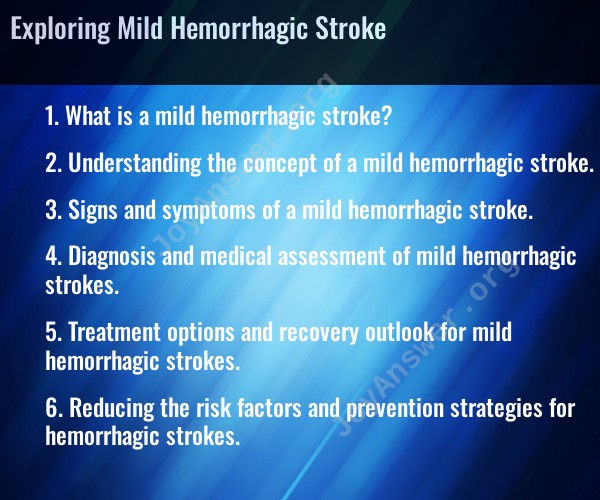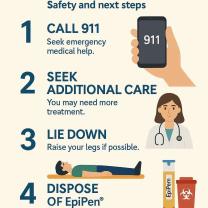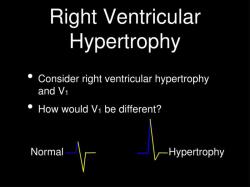What is a mild hemorrhagic stroke?
A mild hemorrhagic stroke, also known as a mild hemorrhagic cerebral event, refers to a type of stroke that occurs when there is bleeding into the brain, often due to a ruptured blood vessel or an aneurysm. Hemorrhagic strokes are less common than ischemic strokes, but they can be very serious. A "mild" hemorrhagic stroke is a relative term and does not imply that the condition is not serious; rather, it suggests that the neurological deficits or the extent of brain damage resulting from the bleed may be less severe compared to a more severe hemorrhagic stroke.
Key characteristics of a mild hemorrhagic stroke may include:
Limited Neurological Deficits: Individuals who experience a mild hemorrhagic stroke may have mild or moderate neurological symptoms, which can vary from person to person. Common symptoms might include headache, weakness on one side of the body, difficulty speaking, or changes in vision or balance.
Consciousness and Awareness: Many individuals with mild hemorrhagic strokes remain conscious and aware of their surroundings, although they may experience confusion or disorientation.
Less Severe Brain Damage: The bleeding in a mild hemorrhagic stroke is typically localized and does not affect a large area of the brain. As a result, the extent of brain damage may be limited.
Prognosis: In some cases, individuals with mild hemorrhagic strokes may have a better prognosis and may experience less disability compared to those with severe hemorrhagic strokes. However, recovery can vary widely based on factors such as the location of the bleed, the individual's overall health, and the speed of medical intervention.
Prompt Medical Attention: Regardless of the severity, all cases of hemorrhagic stroke, including mild ones, require immediate medical attention. Treatment options may include surgery to repair the source of bleeding, medications to manage blood pressure and prevent further bleeding, and interventions to control intracranial pressure.
It's important to recognize that the term "mild" does not diminish the seriousness of a hemorrhagic stroke. Even mild cases can result in long-term neurological deficits and complications, so seeking immediate medical help is crucial. Identifying the type and location of the bleed, along with providing appropriate medical treatment, can significantly impact the outcome and recovery of an individual who has experienced a hemorrhagic stroke.
Understanding the concept of a mild hemorrhagic stroke
A hemorrhagic stroke occurs when a blood vessel in the brain ruptures, causing bleeding into the brain tissue. This can damage or destroy brain cells and lead to a variety of neurological symptoms.
A mild hemorrhagic stroke is a stroke that causes minor damage to the brain. People with mild hemorrhagic strokes may experience some symptoms, but they are usually able to make a full recovery.
Signs and symptoms of a mild hemorrhagic stroke
The signs and symptoms of a mild hemorrhagic stroke can vary depending on the area of the brain that is affected. However, some common symptoms include:
- Sudden headache, often severe
- Dizziness or loss of balance
- Nausea or vomiting
- Numbness or weakness in the face, arm, or leg, especially on one side of the body
- Confusion or difficulty speaking
- Difficulty seeing in one or both eyes
- Slurred speech
- Drooping eyelid
- Difficulty walking
If you experience any of these symptoms, it is important to seek medical attention immediately.
Diagnosis and medical assessment of mild hemorrhagic strokes
To diagnose a hemorrhagic stroke, doctors will typically perform a physical examination and ask about your medical history. They may also order imaging tests, such as a CT scan or MRI, to get a better view of the brain and identify the source of the bleeding.
Treatment options and recovery outlook for mild hemorrhagic strokes
The treatment for a mild hemorrhagic stroke will depend on the severity of the stroke and the underlying cause. In some cases, no treatment may be necessary. However, in other cases, medications may be used to control blood pressure, reduce inflammation, and prevent seizures.
Most people with mild hemorrhagic strokes are able to make a full recovery. However, some people may experience long-term effects, such as difficulty with memory, speech, or movement.
Reducing the risk factors and prevention strategies for hemorrhagic strokes
There are a number of things you can do to reduce your risk of a hemorrhagic stroke, including:
- Controlling blood pressure
- Managing cholesterol levels
- Maintaining a healthy weight
- Exercising regularly
- Eating a healthy diet
- Quitting smoking
- Limiting alcohol intake
If you have any of the following risk factors for a hemorrhagic stroke, it is important to talk to your doctor about ways to reduce your risk:
- High blood pressure
- High cholesterol
- Diabetes
- Heart disease
- Obesity
- Smoking
- Family history of stroke
By taking steps to reduce your risk factors, you can help to prevent a hemorrhagic stroke.













